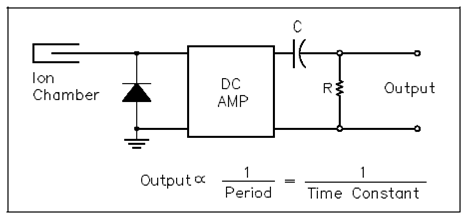Period Meters and Startup Rate:
In several applications it is necessary to know the rate of change of power. This rate generally increases or decreases exponentially along with time. The time constant for this change is referred to as the period. A period of five seconds which means in the value changes through a factor of e (2.718) in five seconds. The above Figure displays a basic period meter circuit.

Figure: Period Meter Circuit
Placing the signal by an RC circuit causes a voltage which is proportional to the reciprocal of the period no current flows through resistor R if the current outcome from the ionization chamber is constant, and the outcome voltage is zero. This corresponds to an infinite period. Since the ion chamber output current changes, there is a voltage transient across capacitor C, and current flows through resistor R. The more rapid the transient, the greater the voltage drop across resistor R, and the shorter the period.
Rate information is displayed on a meter in decades per minute, and because it is used by the operator to monitor the rate of change of power in during startup, it is termed startup rate. Startup rate (SUR) equates to reactor period by using Equation 6-10.
SUR = 26.06/τ (6-10)
where
SUR = startup rate in decades per minute
26.06 = constant
τ = reactor period in seconds
The reactor operator adjusts control rods so which an upper limit, such as 1 DPM, is not exceeded. This permits an orderly increase in reactor power.